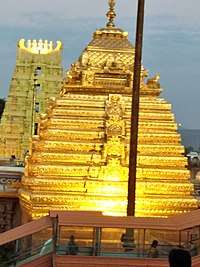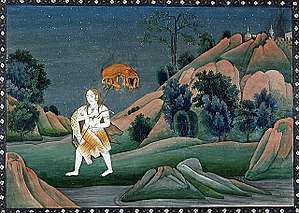Mallikarjuna Jyotirlinga
| Mallikarjuna Jyotirlinga | |
|---|---|
 Entrance to Srisailam Devasthanam | |
| Geography | |
| Coordinates | 16°04′27″N 78°52′05″E / 16.07417°N 78.86806°ECoordinates: 16°04′27″N 78°52′05″E / 16.07417°N 78.86806°E |
| Country | India |
| State | Andhra Pradesh |
| Locale | Srisailam |
| Culture | |
| Sanctum |
Mallikarjuna (Shiva) Bhramaramba (Parvati) |
| Major festivals | Maha Shivaratri, Navratri |
| Architecture | |
| Number of temples | 2 |
Sri Bhramaramba Mallikarjuna Temple is a Hindu temple dedicated to the deities Shiva and Parvati, located at Srisailam in Indian state of Andhra Pradesh. It is significant to the Hindu sects of both Shaivam and Shaktam as this temple is referred to as one of the twelve Jyothirlingas of Lord Shiva and as one of the eighhteen Shakti Peethas of goddess Parvati. Shiva is worshiped as Mallikarjuna, and is represented by the lingam. His consort Parvati is depicted as Brahmaramba. It is the only temple in India which is revered as both Jyotirlinga and Shaktipeeth.
Legend
When Shiva and Parvati decided to find suitable brides for their sons, Ganesha and Kartikeya argued as to who is to get wedded first. Shiva bade that the one who goes round the world in Pradakshinam could get married first. By the time Kartikeya could go round the world on his vahana, Ganesha went round his parents 7 times (for according to Shastras, going in pradakshinam round one's parents is equivalent to going once round the world (Bhupradakshinam)). Siva got Buddhi(intellect), Siddhi (spiritual power), and Riddhi (prosperity) married to Ganesha. Kartikeya on his return was enraged and went away to stay alone on Mount Kraunja in the name of Kumarabrahmachari. On seeing his father coming over to pacify him, he tried to move to another place, but on the request of the Devas, stayed close by. The place where Siva and Parvati stayed came to be known as Shrishailam.[1]

As per Hindu legend, the presiding deity in the form of Linga (an iconic form of Shiva) was worshipped with jasmine (locally called Mallika), leading to the name of presiding deity as Mallikarjuna.[2]
Mahashivratri is the main festival celebrated at Srisailam Mallikarjuna Swamy temple.
History
There are inscriptional evidences from the Satvahana Dyanasty which place the temple to be existent from the 2nd century. Most modern additions were done during the time of king Harihara of Vijayanagara Empire.[2]
Architecture
The temple complex covers 2 hectares and houses four gateway towers known as gopurams. The temple has numerous shrines, with those of Mallikarjuna and Bhramaramba being the most prominent. The temple complex houses many halls; the most notable is the Mukha Mandapa built during the Vijayanagar period. The temple is situated facing East. The center mandapam has several pillars, with a huge idol of Nadikeshwara. The temple is enclosed by tall walls measuring 183 m (600 ft) by 152 m (499 ft) and 8.5 m (28 ft) tall. There are a number of sculptures in the precinct each raising above another. The Mukamandapa, the hall leading to the sanctum, has intricate sculpted pillars. The shrine where Mallikarjuna is housed is considered the oldest in the temple, dating back to 7th century. There is a Sahasra linga (1000 linga), believed to have been commissioned by Rama and five other lingas believed to have been commissioned by Pandavas. A mirror hall in the first precinct has images of Nataraja.[2]
Administration
The temple is maintained and administered by Chenchus.[2]
Religious significance
Lord Shiva in this temple is referred to as one of the twelve Jyotirlingas. Goddess Bramarambha's shrine is referred to as one of the eighteen Shakti peethas. This temple is classified as one of the Paadal Petra Sthalam.
Jyotirlinga
As per Siva Mahapuranam, once Brahma (the Hindu God of creation) and Vishnu (the Hindu God of preservation) had an argument in terms of supremacy of creation.[3] To test them, Shiva pierced the three worlds as a huge endless pillar of light, the jyotirlinga. Vishnu and Brahma split their ways to downwards and upwards respectively to find the end of the light in either directions. Brahma lied that he found out the end, while Vishnu conceded his defeat. Shiva appeared as a second pillar of light and cursed Brahma that he would have no place in ceremonies while Vishnu would be worshipped till the end of eternity. The jyotirlinga is the supreme partless reality, out of which Shiva partly appears. The jyotirlinga shrines, thus are places where Shiva appeared as a fiery column of light.[4][5] Originally there were believed to be 64 jyotirlingas while 12 of them are considered to be very auspicious and holy.[3] Each of the twelve jyotirlinga sites take the name of the presiding deity – each considered different manifestation of Shiva.[6] At all these sites, the primary image is lingam representing the beginningless and endless Stambha pillar, symbolizing the infinite nature of Shiva.[6][7][8] The twelve jyotirlinga are Somnath in Gujarat, Mallikarjuna at Srisailam in Andhra Pradesh, Mahakaleswar at Ujjain in Madhya Pradesh, Omkareshwar in Madhya Pradesh, Kedarnath in Himalayas, Bhimashankar in Maharashtra, Viswanath at Varanasi in Uttar Pradesh, Triambakeshwar in Maharashtra, Vaidyanath at Deoghar district in [Jharkhand ], Nageswar at Dwarka in Gujarat, Rameshwar at Rameswaram in Tamil Nadu and Grishneshwar at Aurangabad in Maharashtra.[3][9]
Shakti Peeth

Srisailam Sri Mallikarjuna Swamy Temple is one of the 18 Maha Shakti Peetha. The legend of Daksha yaga and Sati's self immolation resulted in the emergence of Sri Parvati in the place of Sati Devi and making Shiva a house holder. This mythology is the story behind the origin of Shakti Peethas. They are holy abodes of Adiparashakti formed due the falling of Sati Devi's corpse when Shiva carried it and wandered. It is believed that Sati Devi's Upper lip has fallen here.[10]
Festivals and rituals
Maha Shiva Ratri is the most important festival here. Also Navaratri too.
References
- ↑ Lochtefeld, James G. (2002). The Illustrated Encyclopedia of Hinduism: A-M. The Rosen Publishing Group. p. 413. ISBN 978-0-8239-3179-8.
- 1 2 3 4 Harshananda, Swami (2012). Hindu Pilgrim centres (2nd ed.). Bangalore, India: Ramakrishna Math. pp. 131–3. ISBN 81-7907-053-0.
- 1 2 3 R. 2003, pp. 92-95
- ↑ Eck 1999, p. 107
- ↑ See: Gwynne 2008, Section on Char Dham
- 1 2 Lochtefeld 2002, pp. 324-325
- ↑ Harding 1998, pp. 158-158
- ↑ Vivekananda Vol. 4
- ↑ Chaturvedi 2006, pp. 58-72
- ↑ "Kottiyoor Devaswam Temple Administration Portal". kottiyoordevaswom.com/. Kottiyoor Devaswam. Retrieved 20 July 2013.
Notes
- Chaturvedi, B. K. (2006), Shiv Purana (First ed.), New Delhi: Diamond Pocket Books (P) Ltd, ISBN 81-7182-721-7
- Eck, Diana L. (1999), Banaras, city of light (First ed.), New York: Columbia University Press, ISBN 0-231-11447-8
- Gwynne, Paul (2009), World Religions in Practice: A Comparative Introduction, Oxford: Blackwell Publication, ISBN 978-1-4051-6702-4 .
- Harding, Elizabeth U. (1998). "God, the Father". Kali: The Black Goddess of Dakshineswar. Motilal Banarsidass. pp. 156–157. ISBN 978-81-208-1450-9.
- Lochtefeld, James G. (2002), The Illustrated Encyclopedia of Hinduism: A-M, Rosen Publishing Group, p. 122, ISBN 0-8239-3179-X
- R., Venugopalam (2003), Meditation: Any Time Any Where (First ed.), Delhi: B. Jain Publishers (P) Ltd., ISBN 81-8056-373-1
- Vivekananda, Swami. "The Paris Congress of the History of Religions". The Complete Works of Swami Vivekananda. Vol.4.
External links
| Wikimedia Commons has media related to Mallikarjuna Jyotirlinga. |

